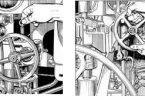Bulk carriers are designed and approved to carry a variety of cargoes. The distribution of cargo along the ship’s length has a direct influence on both the global bending and shearing of the hull girder and on the stress in the localised hull structure.
The more commonly adopted cargo distributions are:
- Homogeneous hold loading condition.
- Alternate hold loading condition.
- Block hold loading condition.
- Part hold loading condition.
Homogeneous Hold Loading Conditions (Fully Loaded)
A homogeneous hold loading condition refers to the carriage of cargo, evenly distributed in all cargo holds. This loaded distribution, in general, is permitted for all bulk carriers and is usually adopted for the carriage of light (low density) cargoes, such as coal and grain. However, heavy (high density) cargoes such as iron ore may be carried homogeneously.

Fig: Homogeneous Hold Loading Conditions (Fully Loaded)
Alternate Hold Loading Conditions (Fully Loaded)
Heavy cargo, such as iron ore, is often carried in alternate cargo holds on bulk carriers. It is common for large bulk carriers to stow high density cargo in odd numbered holds with the remaining holds empty. This type of cargo distribution will raise the ship’s centre of gravity, which eases the ship’s rolling motion.
When high density cargo is stowed in alternate holds, the weight of cargo carried in each hold is approximately double that carried in a homogeneous load distribution.
To support the loading of the heavy cargo in the holds, the local structure needs to be specially designed and reinforced. It is important to note that the holds which remain empty, with this type of cargo distribution, have not been reinforced for the carriage of heavy cargoes with a non-homogeneous distribution.
Ships not approved for the carriage of heavy cargoes in alternate holds by their classification society must not adopt this cargo load distribution.

Fig : Alternate Hold Loading Conditions
Block Hold Loading and Part Loaded Conditions
A block hold loading condition refers to the stowage of cargo in a block of two or more adjoining cargo holds with the cargo holds adjacent to the block of loaded cargo holds empty.
In many cases, block hold loading is adopted when the ship is partly loaded. Part loaded and block hold loading conditions are not usually described in the ship’s loading manual unless they are specially requested to be considered in the design of the ship.
When adopting a part loaded condition, to avoid over-stressing of the hull structure, careful consideration needs to be given to the amount of cargo carried in each cargo hold and the anticipated sailing draught.
When a ship is partly loaded, the cargo transported is less than the full cargo carrying capacity of the ship. Hence, the sailing draught of the ship is likely to be less than its maximum design draught.
The weight of cargo in each hold must be adequately supported by the buoyancy upthrust acting on the bottom shell. A reduction in the ship’s draught causes a reduction in the buoyancy upthrust on the bottom shell to counteract the downward force exerted by the cargo in the hold. Therefore,when a ship is partly loaded with a reduced draught, it may be necessary to reduce the amount of cargo carried in any hold.
To enable cargoes to be carried in blocks, the cross deck and double bottom structure needs to be specially designed and reinforced. Block loading results in higher stresses in the localised structure in way of the cross deck and double bottom structures and higher shear stress in the transverse bulkheads between the block loaded holds. The weight of cargo that can be carried in the block of cargo holds needs to be specially considered against the ship’s sailing draught and the capability of the structure.

Fig : Block hold loading conditions
In general, the cargo load that can be carried in blocks is much less than the sum of the full cargo capacity of the individual holds at the maximum draught condition.
Part loaded and block hold loading conditions should only be adopted in either of the following situations:



Hello there.
i don’t know if it is “my” wrong/fault or not, but figures in this article….are missing.
Have a nice day
Nikos